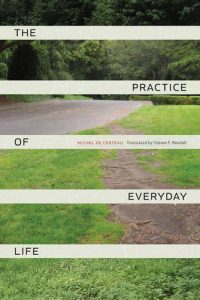
Although Michel de Certeau’s “The Practice of Everyday Life” was initially quite difficult to interpret, there were some aspects, upon further investigation, that I believe really encapsulated the overall message he attempted to convey. His focus on the distinctions between space and place and his notion that “Stories thus carry out a labor that constantly transforms places into spaces or spaces into places.” was particularly intriguing. De Certeau shows how an individuals narration can help to define a space or place and that these two are actually quite interchangeable and fluid (which is previously through his representation of existence and space as parallel. Prior to this he also defines “determinations in stories” which consist of two options: “a determination through objects that are reducible to being-there” – the law of a place – and “a determination through operations…which specify “spaces.”” In describing these determinations, his rhetoric consists almost entirely of metaphors, using a very morbid lexical set (“dead”, “cadaver”, “tomb” – to name a few.), which aims to show a brief link to the real world – the “”phenomenology” of existing in the world.”
A detailed break down on de Certeau’s idea of space and places. Good Job.